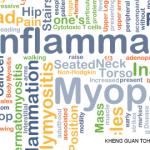 Jemima Albayda, MD, is an associate professor of medicine, director of the rheumatology fellowship program and director of the Musculoskeletal Ultrasound and Injection Clinic in the Division of Rheumatology, Johns Hopkins University School of Medicine, Baltimore. She is a faculty member of the Johns Hopkins Myositis Center.
Jemima Albayda, MD, is an associate professor of medicine, director of the rheumatology fellowship program and director of the Musculoskeletal Ultrasound and Injection Clinic in the Division of Rheumatology, Johns Hopkins University School of Medicine, Baltimore. She is a faculty member of the Johns Hopkins Myositis Center.
References
- Shelly S, Mielke MM, Mandrekar J, et al. Epidemiology and natural history of inclusion body myositis: A 40-year population-based study. Neurology. 2021 May 25;96(21):e2653–e2661.
- Benveniste O, Guiguet M, Freebody J, et al. Long-term observational study of sporadic inclusion body myositis. Brain. 2011 Nov;134(Pt 11):3176–3184.
- Cortese A, Machado P, Morrow J, et al. Longitudinal observational study of sporadic inclusion body myositis: Implications for clinical trials. Neuromuscul Disord. 2013 May;23(5):404–412.
- Dobloug GC, Antal EA, Sveberg L, et al. High prevalence of inclusion body myositis in Norway; a population-based clinical epidemiology study. Eur J Neurol. 2015 Apr;22(4):672–679, e41.
- Gradwohl R, Brant JM. Hospital-based palliative care: Quality metrics that matter. J Adv Pract Oncol. 2015 Nov–Dec;6(6):606–610.
- Naddaf E. Inclusion body myositis: Update on the diagnostic and therapeutic landscape. Front Neurol. 2022 Sep 27:13:1020113.
- Taira K, Yamamoto T, Mori-Yoshimura M, et al. Obstruction-related dysphagia in inclusion body myositis: Cricopharyngeal bar on videofluoroscopy indicates risk of aspiration. J Neurol Sci. 2020 Jun 15:413:116764.
- Warren A, Buss MK. Death by chocolate: The palliative management of dysphagia. J Palliative Med. 2022 Jun;25(6):1004–1008.
- Tani T, Imai S, Fushimi K. Increasing daily duration of rehabilitation for inpatients with sporadic inclusion body myositis may contribute to improvement in activities of daily living: A nationwide database cohort study. J Rehabil Med. 2023 Apr 19:55:jrm00386.
- Bernacki RE, Block SD, American College of Physicians High Value Care Task Force. Communication about serious illness care goals: A review and synthesis of best practices. JAMA Intern Med. 2014 Dec;174(12):1994–2003.
- Wright AA, Zhang B, Ray A, et al. Associations between end-of-life discussions, patient mental health, medical care near death, and caregiver bereavement adjustment. JAMA. 2008 Oct 8; 300(14):1665–1673.
- Curtis JR, Engelberg RA, Nielsen EL, et al. Patient-physician communication about end-of-life care for patients with severe COPD. Eur Respir. 2011 Aug;38(2):268–276.
- Zhang B, Wright AA, Huskamp HA, et al. Health care costs in the last week of life: Associations with end of life conversations. Arch Intern Med. 2009 Mar 9;169(5):480–488.
- Worster B, Swartz K. Telemedicine and palliative care: An increasing role in supportive oncology. Curr Oncol Rep. 2017 Jun;19(6):37.
- Lubinus M, Hu YP, Wilson L, et al. Pos0070-pare caregiver burden among idiopathic inflammatory myopathy (IIM) caregivers. Ann Rheum Dis. 2023 May;82(1):246.
- Rabow MW, Hauser JM, Adams J. Supporting family caregivers at the end of life: They don’t know what they don’t know. JAMA. 2004 Jan 28;291(4):483–491.
- Cannuscio CC, Jones C, Kawachi I, et al. Reverberations of family illness: A longitudinal assessment of informal caregiving and mental health status in the nurses’ health study. Am J Public Health. 2002 Aug;92(8):1305–1311.
- de Wit J, Bakker LA, Groenestijn AC, et al. Caregiver burden in amyotrophic lateral sclerosis: A systematic review. Palliat Med. 2018 Jan;32(1):231–245.
- Capkun G, Tian H, Zhao C, et al. Economic burden of sporadic inclusion body myositis patients in the United States (P1.135). Neurology. 2016 Apr;86(16).
- Bekelman DB, Feser W, Morgan B, et al. Nurse and social worker palliative telecare team and quality of life in patients with COPD, heart failure, or interstitial lung disease: The ADAPT randomized clinical trial. JAMA. 2024 Jan;331(3):212–223.
- Kuchinad K, Nadeem M, Mehta AK, et al. Palliative care utilization for hospitalized patients with inclusion body myositis: A nationwide study. J Clin Rheumatol. 2023 Sep;29(6):e130–e133.
- Chang RS, Poon WS. “Triggers” for referral to neurology palliative care service. Ann Palliative Med. 2018 Jul;7(3):289–295.
- McConvey K, Kazazian K, Iansavichene AE, et al. Triggers for referral to specialized palliative care in advanced neurologic and neurosurgical conditions. Neurol Clin Pract. 2022 Jun;12(3):190–202.
- Phillips JN, Besbris J, Foster LA, et al. Models of outpatient neuropalliative care for patients with amyotrophic lateral sclerosis. Neurology. 2020 Oct 27;95(17):782–788.


